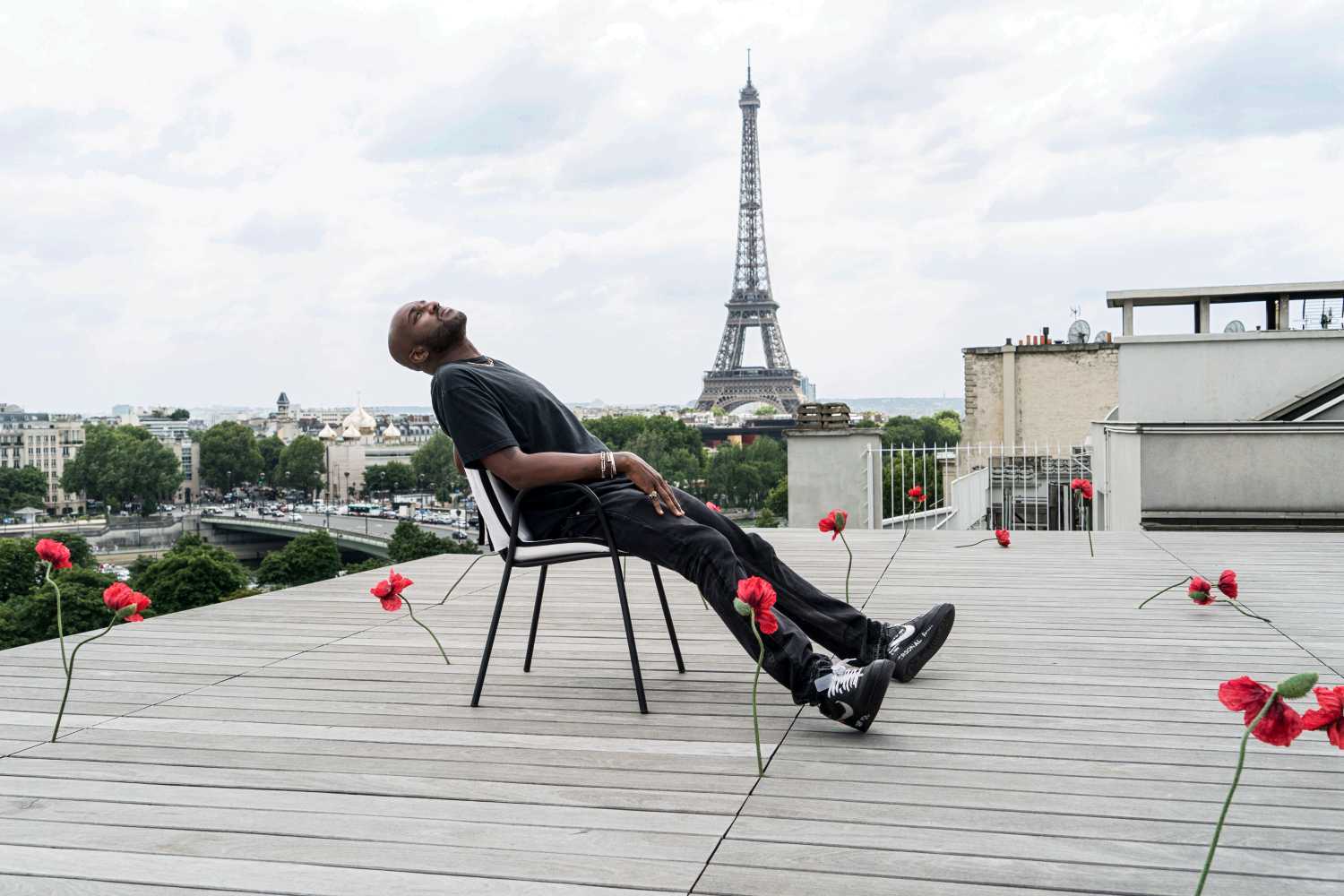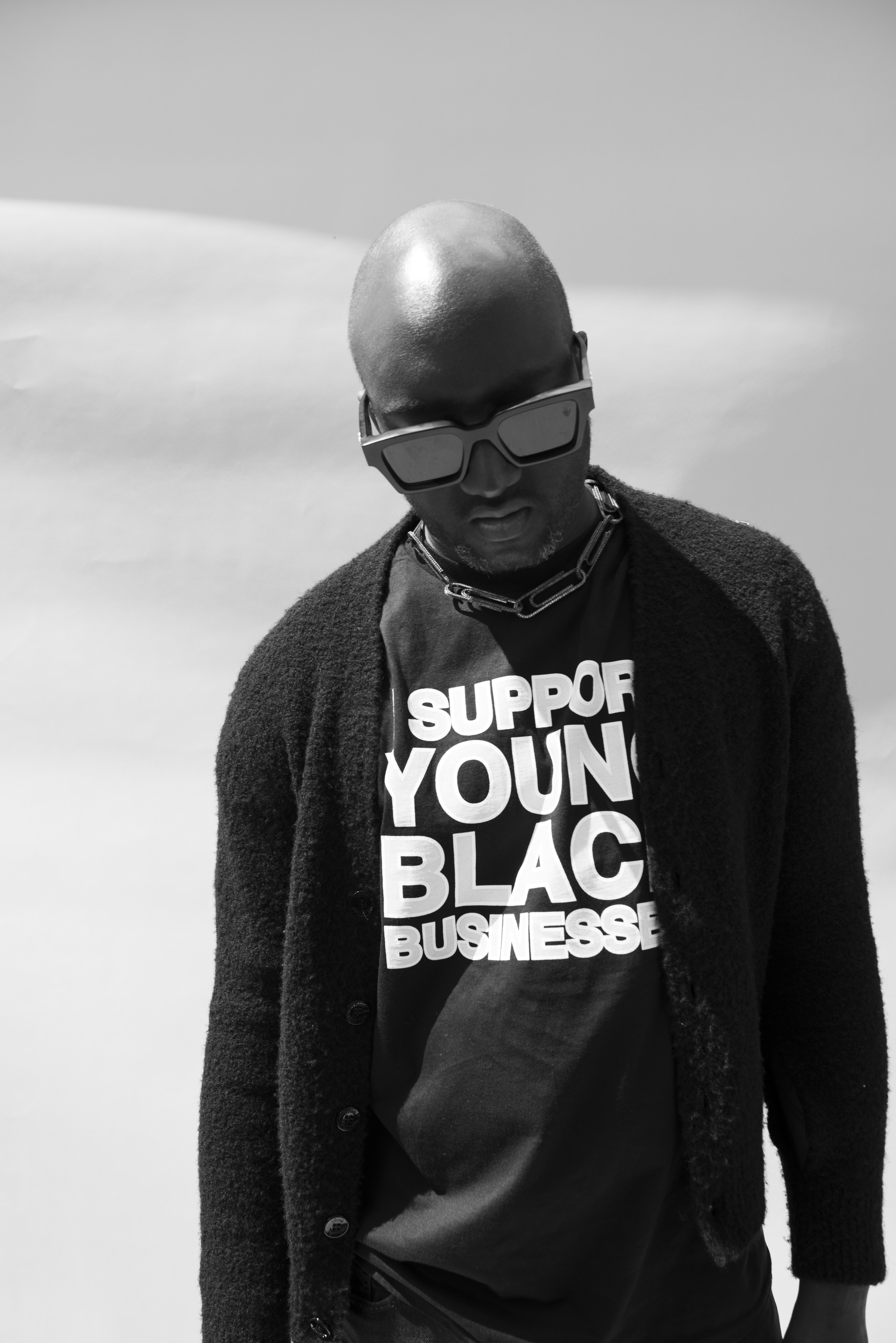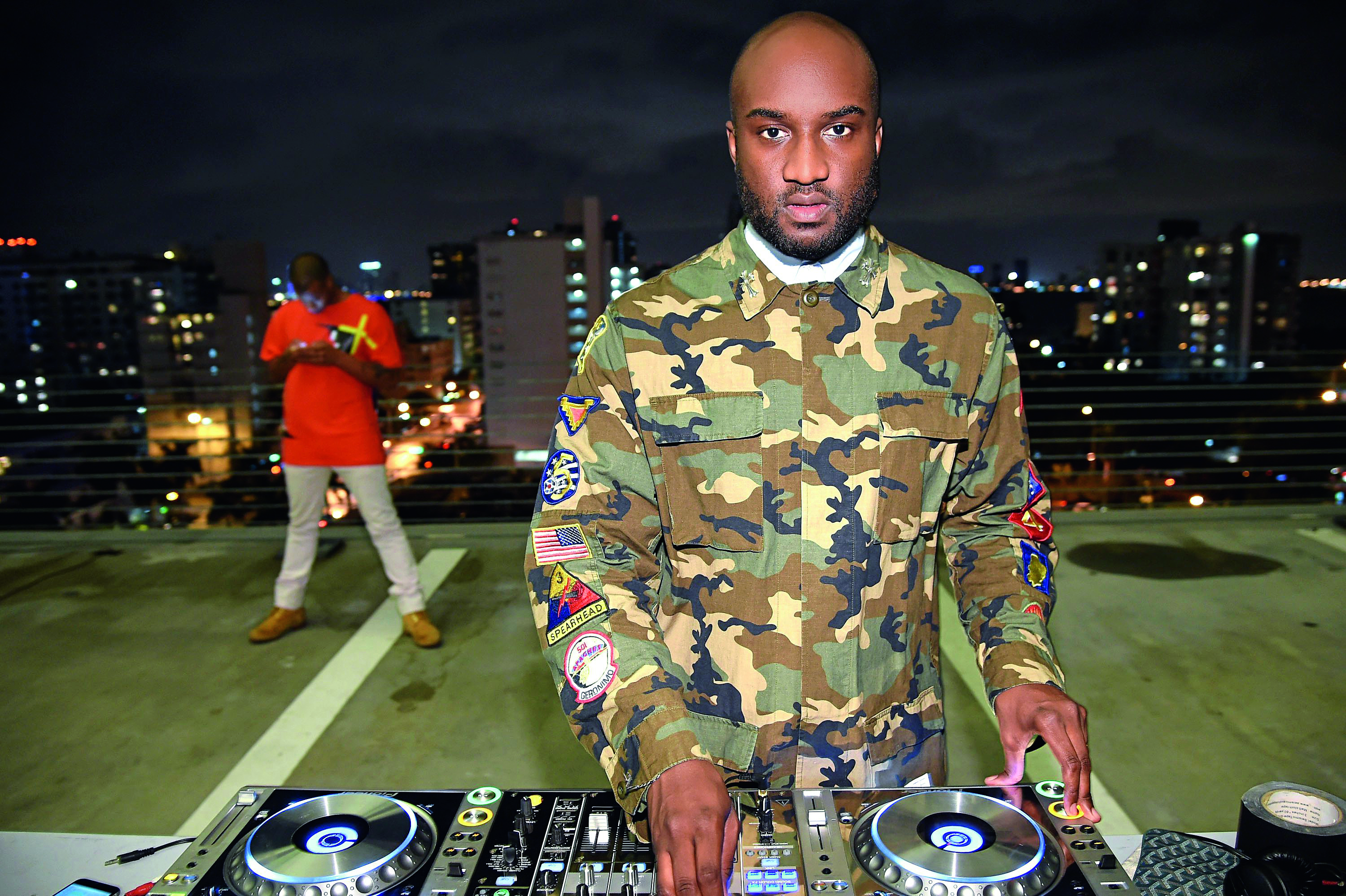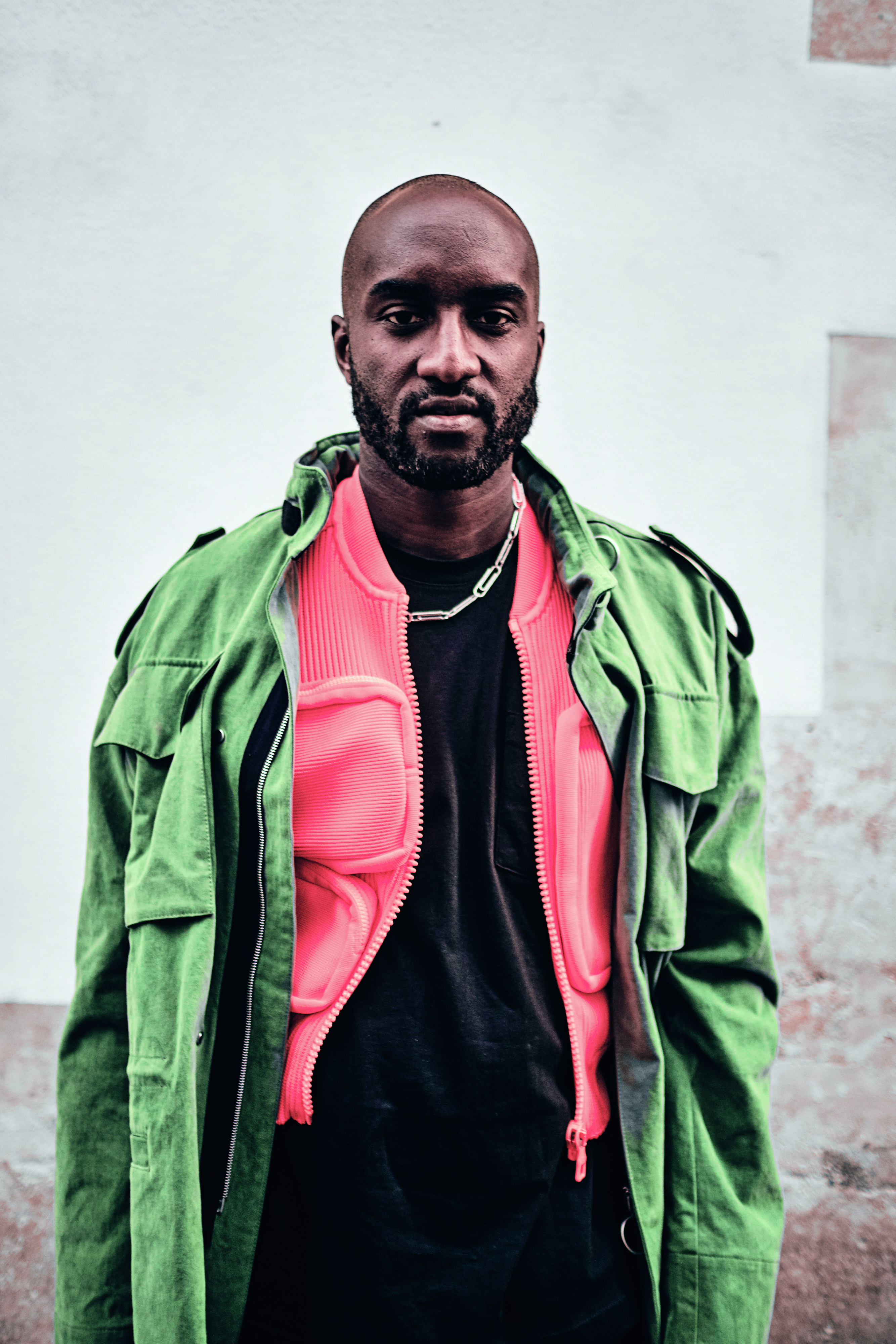
It was early last November that I arrived at Doha’s Fire Station for a tour of “Figures of Speech”. Virgil Abloh and curator Samir Bantal greeted the small group of assembled press with the kind of intimacy usually reserved for close friends. Sunglasses on and armed with a double espresso, battling exhaustion from a week of fashion and design events courtesy of Qatar Creates, we began what was to be Abloh’s last press tour at his final exhibition.
Presented as an in-depth look at the creative’s diverse and pioneering media practice across visual arts, music, fashion, architecture and design, and featuring more than 55 works, the exhibition had been billed as a mid-career retrospective – but “Figures of Speech” wasn’t grounded in the past. Less about looking back and more about appreciating the present, the works on display – whether a rug created in collaboration with IKEA in 2019 or his “Illinois Institute of Technology Master’s Thesis Building” cityscape designed as part of his Master’s degree in Architecture – were part of a conversation and journey that had led the designer and artist to arrive at this moment. Defying chronology, wherever “Figures of Speech” took us, Abloh was resolutely and defiantly grounded in the ‘now’.
That sentiment found its affinity in the curation of the exhibition. “When we started working on the show, the initial idea was to present it in chronological order,” said Bantal. “But we realised it was much more interesting to talk about the network that Abloh moves between – fashion, music, art, design, and architecture. That kind of fluidity was actually much more important than a simple chronological overview of the work because not only do you have a sense of the disciplines he’s able to navigate through, but also, at the same time, an understanding of a network within a network in terms of creating collaborations with thinkers, artists, writers, and designers. He uses his own skills as a passport through all these different disciplines, and so the show is built up from different chapters – we have the Early Work, Fashion, Streetwear, Music, Black Gaze, Design, and The End [a section of the exhibition that presents recent works that are emblematic of Abloh’s practice of critiquing the influence of advertising]. As you walk through, you start to see things that return, networks that exist – and because of that setup, it can actually continue to grow over time.”
“The key, as Samir was saying, is the community,” continued Abloh. “That’s the underpinning of the research – this community that I foster, but also represent; this generation of creators that are cross-disciplinary. It goes into the first works for Louis Vuitton – the T-shirts made for the guests to wear at the first fashion show [as Artistic Director, Menswear], all in a rainbow array, a crowd mixed together, so that all the colours combined.”

His voice was unwaveringly articulate. I found myself enraptured – a feeling that I had previously only experienced with performance artist Marina Abramović. His works, brilliant and laden with meaning, were just the beginning. As he spoke, his mind took him in THE COMPASS WORDS BIANCA BRIGITTE BONAMI new directions, identifying new possibilities, mapping new territories. I recalled a verse from John Donne, taken out of its original context and pervaded with new meaning by Abloh: “If they be two, they are two so / As stiff twin compasses are two; / Thy soul, the fixed foot, makes no show / To move, but doth, if the other do.” The exchange felt symbiotic; we relied on Abloh’s vision to steer us and he, in turn, relied on us, his community, to draw from him and allow ourselves the freedom to take our own thinking further. He had the unique ability to sweep up his audience, to surprise and excite us, so that – like the compass – should he stand still, we would orbit around him; following his chain of thought as we followed him dutifully around the exhibition space. As he spoke, my tiredness disappeared like a horizon in mist so much so that later that night I headed to Nobu at Four Seasons Doha, a space that Abloh had hired to host a celebratory party. He took to the decks as Naomi Campbell sashayed on the dancefloor and I stood behind him – arms flailing, screaming out lyrics – like an ID-less 15-year-old enjoying her first foray in a club.
As we continued our tour of the Fire Station, we heard Abloh’s distinctive voice ring out in Early Work, a gallery in which viewers encounter “A Team With No Sport” (2012); a video he had made to promote his Pyrex Vision brand. In the video, Black youth wear sweatshirts and T-shirts that Abloh has printed with the words “Pyrex 23.” “This work was pivotal in my career in terms of mixing disciplines,” Abloh explained. “It wasn’t a fashion project, it was more about capturing in film the youth energy in New York that would one day influence fashion. It’s the idea that fashion and identity aren’t about the clothes, they are about the comradery and what’s happening amongst the new generation.” Despite the Pyrex Vision line selling out in minutes, the critical response after the film debuted was less favourable, branding the pieces as too expensive. “So this starts to bring into play the question of what is valuable,” Abloh said. “Were they too expensive because of my ethnicity? Were they too expensive because of my point of view?” One of the write-ups that contextualised the film, by critic Jian DeLeon for Four Pins, argued that ‘It’s entirely possible Pyrex simply bought a bunch of Rugby flannels, slapped ‘PYREX 23’ on the back, and re-sold them for an astonishing mark-up of about 700%.’ Abloh’s response was to print the DeLeon quote on a large black rug, which formed part of the exhibition. “We created this rug as a figurative way to deal with the critical response,” Abloh said. “There is always a barrier to create, there’s always going to be someone telling you that you’ve gone too far. That’s what this whole exhibit is – it’s about existing, doing things differently, challenging the norm.” As for the art critic? “I’m friends with him to this day, he has one of the rugs in his office. I sent it to him.”

A printed still from the film was one of the many pieces I rushed to buy at the gift shop; piling up T-shirts and hoodies that Abloh graciously signed. One such print bore the word “Television” in white text on a black background. “I don’t have a TV,” I explained to him. “So I will hang this where one might have been.”
Throughout the exhibition, and throughout his career, Abloh explored the notion of “purist and tourist”; those that are part of the institution – the art historians, the critics – and those who remain outside of it but are excited by art, music and fashion and can see themselves within it. “When it comes to critical responses,” he said, “I’m asking the question do these things matter? They matter a lot but they also don’t matter at all. A body of work that exemplifies and investigates that, was my practice 20 years ago and still is today.”
“Figures of Speech” had the feel of a jigsaw puzzle in which each gallery was a piece required for the viewer to form a complete picture. Streetwear and its relationship to the subcultures of hip-hop and skateboarding found its way into Fashion and Music – the latter section featuring album covers and curated Off-White show soundtracks. ‘Making of’ elements; prototypes as well as finished artworks, attributed the exhibition with the quality of feeling both done and undone. “The way my practice is set up is sort of like a lexicon – one work creates more work and then creates different outlets. So the sonic contribution, the music for the score, was meticulously made to give context to my work. What you see here [pointing to a custom transparent CDJs and mixer created in collaboration with Pioneer DJ] is the first of its kind ever produced. The sound you are hearing is the soundtrack from consecutive Off-White shows, curated to give context to the work that audiences would see. Just before the fashion shows started, you would hear these interviews. There’s a power to having a recognised voice rearrange the furniture inside someone’s house before they see a body of work. These voices are source texts, in a way. There are so many barriers within one’s brain that have to be unblocked to see fashion from a different point of view, and I use sound as a means to unlock those barriers.”

That fresh point of view was also evident in a display of gold and platinum paper-clip jewellery created in collaboration with jeweller Jacob Arabo. “An important part of hip-hop culture is jewellery and the representative quality that jewellery has,” Abloh explained. “The paperclip is the most inexpensive, elementary piece, but here it is maximalised, made the most it can be, with pavé stones. Again that’s very much my DNA and signature. It plays with perception, it plays with the ability to see yourself in it. So these works are different iterations on the idea of a paperclip. The paperclip is banal, generic, it’s an object that’s been designed by no specific person, it’s something that’s risen up through humanity, so a deeper layer of the work is an investigation into where design comes from, where art comes from, where hierarchy comes from. I like breaking things down that have a hierarchy.”
That notion of breaking down found its way into The Black Gaze gallery – “a body of work,” said Abloh, “that starts to highlight the elephant in the room of being diverse and operating in an ecosystem that traditionally doesn’t represent the voice of the totality.” Here, audiences were greeted with an Inez & Vinoodh advertising campaign image for Louis Vuitton featuring a three-year-old named Alieyth. The young child appears in the Wizard of Oz sweater from the SS19 collection. Wielding significant influence in terms of reflecting and, more importantly, working to promote and change Black cultural experiences in the United States, Abloh’s focus on a young Black child in men’s luxury clothing asks us what constitutes adulthood but also delves into questions about perception and expectation around race.
In this same gallery, audiences also encountered a large image of a FaceTime screen on an iPhone, based on an observation by video artist and cinematographer Arthur Jafa that the front facing camera of an iPhone captures how someone else looks at oneself especially in terms of their ethnicity and identity. “There’s something about the way that we’ve been trained by these tools in our hands that’s almost beyond a mirror, beyond a photograph, it’s cultural,” said Abloh of Jafa’s work.

This critique continued with “You’re Obviously in the Wrong Place” (2017), a phrase written in bright neon on a black wall. The quote, originally taken from the film Pretty Woman in which Julia Roberts’ character is excluded from an upscale fashion boutique, encapsulates that sense of exclusion felt by many people of colour – from the fashion industry, from the arts and literary worlds, from the critical canon.
It was exactly that exclusion which Abloh sought to redress – ushering in change not with a whisper, but with a roar; questioning everything and accepting nothing. His was a point of view that saw art as extending past the walls of museums and into the streets; into clothes, sneakers, music, and design. His was a validation that came from a life’s work across disciplines and the tangible response to the dialogue he shaped– remembering “the girl who got out of a car and wanted me to sign her Nikes”.
It was just a few weeks later that I lay in bed, phone in hand, scrolling listlessly through Instagram and saw the post announcing Abloh’s passing. My initial thought was that his account had been hacked. Death seemed incongruous with the man I had met – so full of life, so relentless in his creativity. I thought of seeing him, as we left the Fire Station, being lifted by crane, holding a can of graffiti spray to customise an outdoor billboard. It’s how I will remember him – always creating, never stopping, even when the world had no idea of the battle he was fighting. I thought of my “Television” print hanging in the room next door. I thought of dancing at Nobu. I thought of my two-hour tour and the joy it had brought me. I thought of the observations he had made that no one else could see; of the moments of no particular note that he imbued with a special quality, of the fact that there was never a nothing with him but always a something. What would Abloh make of a compass that has lost one of its arms, I wondered? No doubt he would find both merit and meaning.
Listen to Virgil Abloh speak to GRAZIA’s Editor-in-Chief Alison Tay in a recorded conversation that now lives in his personal archive.
This essay is published in the third edition of GRAZIA Middle East. Click here to discover more from THE JOURNEY.









